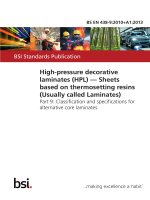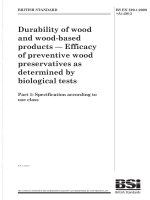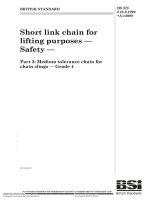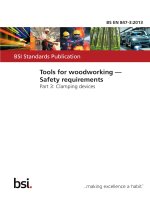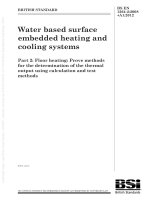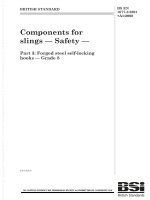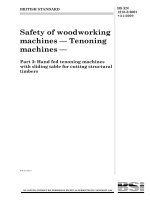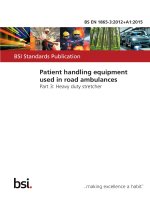Bsi bs en 00845 3 2013 + a1 2016
Bạn đang xem bản rút gọn của tài liệu. Xem và tải ngay bản đầy đủ của tài liệu tại đây (1.35 MB, 34 trang )
BS EN 845-3:201 3+A1 :201 6
In corpora tin g corrigen dum September 201 3
BSI Standards Publication
Specification for ancillary
components for masonry
Part 3: Bed joint reinforcement of steel
meshwork
BS EN 845-3:201 3+A1 :201 6
BRITISH STANDARD
National foreword
This British Standard is the UK implementation of
EN 845-3:201 3+A1 :201 6. It supersedes BS EN 845-3:201 3 which is withdrawn.
The start and finish of text introduced or altered by amendment
is indicated in the text by tags. Tags indicating changes to CEN
text carry the number of the CEN amendment. For example, text
altered by CEN amendment A1 is indicated by
.
!"
EN 845-3 specifies the characteristics and performance requirements
for bed joint reinforcement available throughout the CEN member
countries. It aims to do so in product performance terms, avoiding
as far as possible prescriptive requirements and all the traditional
designations of these products available throughout Europe.
EN 845-3 includes clauses covering initial type tests, factory
production control, sampling for initial type testing and
independent testing of consignments. These are similar in all
masonry product specifications.
The UK National Annex NA attached to this standard provides an
informative commentary on EN 845-3. Nothing in this annex should
be construed as specifying requirements other than those contained
in the normative parts of this European Standard.
If CE marking is performed, the procedures in Annex ZA will apply.
The significance of the CE marking is that the product manufacturer
claims compliance with the “harmonized” requirements given in the
normative text of the product standard. These relate to the basic
requirements for construction works as given in the Construction
Products Regulation. Not all product characteristics need necessarily
be given on the CE marking, but those product characteristics
covered by regulations in force in each EU Member State, where the
manufacturer intends that the product will be used, do need to be stated.
The UK participation in its preparation was entrusted by Technical
Committee B/51 9, Masonry and associated testing, to Subcommittee
B/51 9/3, Ancillary components.
A list of organizations represented on this subcommittee can be
obtained on request to its secretary.
This publication does not purport to include all the necessary
provisions of a contract. Users are responsible for its correct
application.
© The British Standards Institution 201 6.
Published by BSI Standards Limited 201 6
ISBN 978 0 580 84585 7
ICS 91 .060.1 0; 91 .080.30
Compliance with a British Standard cannot confer immunity from
legal obligations.
This British Standard was published under the authority of the
Standards Policy and Strategy Committee on 31 August 201 3.
Amendments/corrigenda issued since publication
Date
Text affected
30 September 201 3
Correction to supersession details
30 September 201 6
Implementation of CEN amendment A1 :201 6.
National foreword and National Annex NA updated
EN 845-3:2013+A1
EUROPEAN STANDARD
NORME EUROPÉENNE
EUROPÄISCHE NORM
July 2016
ICS 91.080.30
Supersedes EN 845-3:2013
English Version
Specification for ancillary components for masonry - Part
3: Bed joint reinforcement of steel meshwork
Spộcifications pour composants accessoires de
maỗonnerie - Partie 3: Treillis d'armature en acier pour
joints horizontaux
Festlegungen für Ergänzungsbauteile für Mauerwerk Teil 3: Lagerfugenbewehrung aus Stahl
This European Standard was approved by CEN on 21 March 2013 and includes Amendment 1 approved by CEN on 9 April 2016.
CEN members are bound to comply with the CEN/CENELEC Internal Regulations which stipulate the conditions for giving this
European Standard the status of a national standard without any alteration. Up-to-date lists and bibliographical references
concerning such national standards may be obtained on application to the CEN-CENELEC Management Centre or to any CEN
member.
This European Standard exists in three official versions (English, French, German). A version in any other language made by
translation under the responsibility of a CEN member into its own language and notified to the CEN-CENELEC Management
Centre has the same status as the official versions.
CEN members are the national standards bodies of Austria, Belgium, Bulgaria, Croatia, Cyprus, Czech Republic, Denmark, Estonia,
Finland, Former Yugoslav Republic of Macedonia, France, Germany, Greece, Hungary, Iceland, Ireland, Italy, Latvia, Lithuania,
Luxembourg, Malta, Netherlands, Norway, Poland, Portugal, Romania, Slovakia, Slovenia, Spain, Sweden, Switzerland, Turkey and
United Kingdom.
EUROPEAN COMMITTEE FOR STANDARDIZATION
C O M I TÉ E URO PÉ E N D E N O RM ALI S ATI O N
E URO PÄI S C H E S KO M I T E E FÜR N O RM UN G
CEN-CENELEC Management Centre: Avenue Marnix 17, B-1000 Brussels
© 2016 CEN
All rights of exploitation in any form and by any means reserved
worldwide for CEN national Members.
Ref. No. EN 845-3:2013+A1:2016 E
BS EN 845-3:2013+A1:2016
EN 845-3:2013+A1:2016 (E)
Contents
Page
European foreword ....................................................................................................................................................... 4
1
Scope .................................................................................................................................................................... 5
2
Normative references .................................................................................................................................... 5
3
3.1
3.2
Terms, definitions and symbols ................................................................................................................. 6
Terms and definitions ................................................................................................................................... 6
Symbols ............................................................................................................................................................... 7
4
4.1
4.2
4.2.1
4.2.2
4.2.3
4.2.4
Materials and types of products ................................................................................................................. 8
Materials ............................................................................................................................................................. 8
Types of products ......................................................................................................................................... 11
General ............................................................................................................................................................. 11
Welded wire meshwork ............................................................................................................................. 11
Woven wire meshwork .............................................................................................................................. 11
Expanded metal meshwork ...................................................................................................................... 12
5
5.1
5.2
5.2.1
5.2.2
5.3
5.3.1
5.3.2
5.3.3
5.3.4
5.4
5.4.1
5.4.2
5.5
5.6
5.7
Requirements ................................................................................................................................................ 12
General ............................................................................................................................................................. 12
Product applications and types ............................................................................................................... 13
Products for structural use ....................................................................................................................... 13
Products for non-structural use.............................................................................................................. 13
Dimensions and limit deviations ............................................................................................................ 13
General ............................................................................................................................................................. 13
Determination of wire size ....................................................................................................................... 14
Determination of cross-sectional area ................................................................................................. 14
Determination of other dimensions ...................................................................................................... 15
Mechanical strength .................................................................................................................................... 15
Mechanical strength of bed joint reinforcement for structural applications ........................ 15
Mechanical strength of bed joint reinforcement for non-structural
applications .................................................................................................................................................... 16
Bond strength and anchorage length .................................................................................................... 16
Durability ........................................................................................................................................................ 16
Dangerous substances ................................................................................................................................ 16
6
Description and designation .................................................................................................................... 17
7
Marking ............................................................................................................................................................ 17
8
8.1
8.2
8.2.1
8.2.2
8.2.3
8.2.4
8.3
8.3.1
8.3.2
Assessment and verification of constancy of performance – AVCP............................................ 18
General ............................................................................................................................................................. 18
Type testing .................................................................................................................................................... 18
General ............................................................................................................................................................. 18
Test samples, testing and compliance criteria .................................................................................. 19
Test reports .................................................................................................................................................... 19
Shared other party results ........................................................................................................................ 19
Factory production control (FPC) .......................................................................................................... 20
General ............................................................................................................................................................. 20
Requirements ................................................................................................................................................ 20
2
BS EN 845-3:2013+A1:2016
EN 845-3:2013+A1:2016 (E)
8.3.3 Product specific requirements ................................................................................................................ 23
8.3.4 Procedure for modifications .................................................................................................................... 24
Annex A (informative) Guidance on FPC frequencies .................................................................................... 25
! Annexprovisions
ZA"
Clauses of this European Standard addressing the
of the EU Construction Products Regulation ................................................................ 26
(informative)
ZA.1
Scope and relevant characteristics ........................................................................................................ 26
ZA.2
System of Assessment and Verification of Constancy of Performance (AVCP) ...................... 27
ZA.3
Assignment of AVCP tasks ......................................................................................................................... 27
Bibliography ................................................................................................................................................................. 28
3
BS EN 845-3:2013+A1:2016
EN 845-3:2013+A1:2016 (E)
European foreword
This document (EN 845-3: 2013+A1: 2016) has been prepared by Technical Committee
CEN/TC 125 “Masonry”, the secretariat of which is held by BSI.
This European Standard shall be given the status of a national standard, either by publication of
an identical text or by endorsement, at the latest by January 2017, and conflicting national
standards shall be withdrawn at the latest by April 2018.
Attention is drawn to the possibility that some of the elements of this document may be the
subject of patent rights. CEN [and/or CENELEC] shall not be held responsible for identifying any
or all such patent rights.
This document includes Amendment 1 approved by CEN on 2016-04-09.
This document supersedes
! EN 845-3: 2013 " .
!"
The start and finish of text introduced or altered by amendment is indicated in the text by tags
.
This document has been prepared under a mandate given to CEN by the European Commission
and the European Free Trade Association, and supports essential requirements of
EU Directive(s).
For relationship with EU Directive(s), see informative Annex ZA, which is an integral part of this
document.
! deleted text"
EN 845, Specification for ancillary components for masonry, consists of the following parts:
— Part 1 : Wall ties, tension straps, hangers and brackets
— Part 2: Lintels
— Part 3: Bed joint reinforcement of steel meshwork
According to the CEN/CENELEC Internal Regulations, the national standards organizations of
the following countries are bound to implement this European Standard: Austria, Belgium,
Bulgaria, Croatia, Cyprus, Czech Republic, Denmark, Estonia, Finland, Former Yugoslav Republic
of Macedonia, France, Germany, Greece, Hungary, Iceland, Ireland, Italy, Latvia, Lithuania,
Luxembourg, Malta, Netherlands, Norway, Poland, Portugal, Romania, Slovakia, Slovenia, Spain,
Sweden, Switzerland, Turkey and the United Kingdom.
4
BS EN 845-3:2013+A1:2016
EN 845-3:2013+A1:2016 (E)
1 Scope
This European Standard specifies the requirements for masonry bed joint reinforcement for
structural use (see 5 .2 .1 ) and for non-structural use (see 5 .2 .2 ) .
Where products are intended for use in cavity wall construction, this European Standard covers
only the performance of the meshwork as reinforcement in bed joints and not its performance
as wall ties across the cavity.
This European Standard is not applicable to:
a)
products in the form of individual bars or rods;
b)
products formed from materials other than specified grades of austenitic stainless steel,
austenitic ferritic stainless steel, zinc pre-coated steel sheet or zinc coated steel wire with
or without organic coating.
NOTE
Annex ZA refers only to welded wire meshwork intended for structural use referred to in 5 .2 .1
as there are no known regulated requirements for products of this family for non-structural use.
2 Normative references
The following documents, in whole or in part, are normatively referenced in this document and
are indispensable for its application. For dated references, only the edition cited applies. For
undated references, the latest edition of the referenced document (including any amendments)
applies.
EN 846-2 , Methods of test for ancillary components for masonry — Part 2: Determination of bond
strength of prefabricated bed joint reinforcement in mortar joints
EN 846-3 , Methods of test for ancillary components for masonry — Part 3: Determination of shear
load capacity of welds in prefabricated bed joint reinforcement
EN 1 002 0, Definition and classification of grades of steel
EN 1 0088 (all parts) , Stainless steels
EN 1 0143 , Continuously hot-dip coated steel sheet and strip — Tolerances on dimensions and
shape
EN 1 0244 (all parts) , Steel wire and wire products — Non-ferrous metallic coatings on steel wire
EN 1 0245 -1 , Steel wire and wire products — Organic coatings on steel wire — Part 1 : General
rules
EN 1 0245 -2 , Steel wire and wire products — Organic coatings on steel wire — Part 2: PVC
finished wire
EN 1 0245 -3 , Steel wire and wire products — Organic coatings on steel wire — Part 3: PE coated
wire
EN 1 0346, Continuously hot-dip coated steel flat products — Technical delivery conditions
EN ISO 1 5 630 (all parts) , Steel for the reinforcement and prestressing of concrete — Test methods
5
BS EN 845-3:2013+A1:2016
EN 845-3:2013+A1:2016 (E)
3 Terms, definitions and symbols
3.1 Terms and definitions
For the purposes of this document, the following terms and definitions apply.
3.1.1
bed joint
mortar layer between the bed faces of masonry units
3.1.2
bed joint reinforcement
steel reinforcement that is prefabricated for building into a bed joint
3.1.3
bond strength
tensile load that can be resisted by a specified length of reinforcement in a masonry bed joint
3.1.4
characteristic yield strength
value of the yield strength above which 95 % of all the individual test results occur
3.1.5
cross-wires
wires which connect longitudinal wires
3.1.6
declared value
value for a product property, determined in accordance with this standard, that a manufacturer
is confident of achieving bearing in mind the variability of the manufacturing process
3.1.7
element
complete length of bed joint reinforcement either in straight cut lengths or in a roll
3.1.8
anchorage length
minimum embedment of a length of bed joint reinforcement in mortar in order to achieve the
full effectiveness of the reinforcement
3.1.9
longitudinal wire
wire placed parallel to the length of the masonry
3.1.10
meshwork
network created with welded or woven wires or as a result of expanding a strip with a series of
parallel slits
3.1.11
profile height
maximum overall height (distance between the upper and lower surfaces at right angles to the
length and width of the joint) of the embedded portion of the bed joint reinforcement
6
BS EN 845-3:2013+A1:2016
EN 845-3:2013+A1:2016 (E)
3.1.12
shear load capacity
mean value for sample of product specimens of the failure loads at the junction between two
wires loaded in the direction of the longitudinal axis in the plane of the bed joint reinforcement
3.1.13
width
overall dimension in the plane of the bed joint reinforcement measured perpendicular to the
longitudinal axis
3.1.14
wire
longitudinal cold drawn metal of any cross-sectional shape
3.1.15
wire size
diameter of a circle with an area equal to the cross-sectional area of the wire
3.2 Symbols
Ac
is the cross-sectional area of deformed plain wire, in mm 2 ;
Ae
is the cross-sectional area of bed j oint reinforcement, in mm 2 ;
A gt
is the percentage total elongation at maximum force, in %;
a
is the width of the bed joint reinforcement, in mm;
b
is the pitch of the cross-wire, in mm;
c
is the wire size of the longitudinal wires, in mm;
d
is the wire size of the cross-wires, in mm;
e
is the pitch of the longitudinal wires in woven wire meshwork, in mm;
f
is the aperture length of the expanded metal meshwork (centre to centre) , in mm;
g
is the aperture width of the expanded metal meshwork (centre to centre) , in mm;
ls
is the length of a specimen of deformed plain wire or expanded metal meshwork, in mm;
l
is the length of an element of bed j oint reinforcement as delivered by the manufacturer,
in m;
m
is the mass of a specimen of deformed plain wire or expanded metal meshwork, in g;
ρ
is the nominal density of the material, in kg/m 3 ;
Rm
is the tensile strength, in N/mm 2 ;
Re
is the yield strength, in N/mm 2 ;
ReH
is the upper yield strength, in N/mm 2 ;
Rp0,
is the 0,2 % proof strength, non-proportional extension, in N/mm 2 ;
2
Re0,
is the proof strength at a total extension of 0,5 %, in N/mm 2 ;
5
t
is the profile height, in mm.
7
BS EN 845-3:2013+A1:2016
EN 845-3:2013+A1:2016 (E)
4 Materials and types of products
4.1 Materials
Materials for the manufacture of bed joint reinforcement and their protective coatings shall be
selected from those given in Table 1 . Within a product, stainless steel shall not be mixed with
other types of steel.
8
Table 1 — Materials and corrosion protection systems for bed joint reinforcement
Material
Specification for body material a
Material
coating
reference e
Coating specification
Mass per
one side b
Mass per
two sides c
Thickness
per side d
Organic
coating
thickness
g/m 2
g/m 2
μm
μm
Austenitic stainless steel (molybdenum EN 10088 (all parts)
chrome nickel alloys)
—
—
—
—
R1
g
Austenitic stainless steel (chrome nickel EN 10088 (all parts)
alloys)
—
—
—
—
R3
g
Zinc coated steel wire
265
—
—
—
R13
—
—
min. 80
R18
EN 10244 (all parts) zinc coating
f
Zinc coated steel wire with organic coating EN 10244-2 zinc coating and EN 10245 60 f
over all surfaces of finished component
organic coating:
−
Part 1 (EN 10245-1)
−
Part 2 (EN 10245-2) –
Class 2a or 2b
−
Part 3 (EN 10245-3) –
Class 3
Zinc coated steel wire
EN 10020 with EN 10244 (all parts) zinc
coating
60 f
f
-
-
-
R19
-
-
-
R20
9
BS EN 845-3:2013+A1:2016
EN 10020 with EN 10244 (all parts) zinc 105
coating
EN 845-3:2013+A1:2016 (E)
Zinc coated steel wire
mean 100
-
steel strip or sheet
zinc coated steel
Zinc coated steel wire with bonded epoxy
coating over all surface of finished
component
EN 1 002 0 with EN 1 02 44-2 zinc coating
and bonded epoxy coating according to
EN 1 02 45 -1 , Part 1 – General rules
60
Austenitic-ferritic stainless steel
EN 1 0088 (all parts)
-
f
2 75
20
-
-
d
-
R2 1
min. 80
R2 2
EN 845-3:2013+A1:2016 (E)
EN 1 03 46:
BS EN 845-3:2013+A1:2016
10
Zinc pre-coated
mean 1 00
-
-
-
R2 3
g
a
Except where specified, an appropriate grade of steel conforming to EN 1002 0 for zinc-coated products may be chosen.
b
Coating weight is of zinc and is given for one side for wire and post fabrication coatings.
c
Coating weight is of zinc and given for two sides for pre-galvanised sheet products. The mean one side figure will be 5 0 % of the two side figure but not necessarily evenly distributed.
d
Coating thickness refers to the average thickness of metallic protective coating on any uncut surface of a product or any surface of a post-fabrication galvanised product.
e
This number is given to allow unambiguous materials specification and gives no indication of relative performance or quality.
f
On round wire before any subsequent processing.
g
Treatment of stainless steels after fabrication is necessary in relation to welds etc., in order to maintain corrosion resistance of the steel.
BS EN 845-3:2013+A1:2016
EN 845-3:2013+A1:2016 (E)
4.2 Types of products
4.2.1 General
Welded wire meshwork and woven wire meshwork shall be manufactured from smooth,
indented or ribbed wire, round or flattened wire, either of low carbon steel protected against
corrosion or of a corrosion resistant steel. Expanded metal meshwork shall be manufactured
from strip steel of the appropriate thickness and corrosion resistance.
4.2.2 Welded wire meshwork
The reinforcing element produced shall consist of longitudinal wires welded to cross-wires
(ladder type) or to a continuous wire diagonal (truss type) .
NOTE
Examples of products for structural applications are shown in Figures 1 and 2 .
Figure 1 — Example of ladder type - plan and sections
Figure 2 — Example of truss type - plan
4.2.3 Woven wire meshwork
The meshwork shall be made by winding wire around longitudinal wires following a repetitive
pattern.
NOTE
An example of woven wire meshwork is given in Figure 3 .
11
BS EN 845-3:2013+A1:2016
EN 845-3:2013+A1:2016 (E)
Figure 3 — Example of woven wire meshwork - plan and section
4.2.4 Expanded metal meshwork
The meshwork shall be made from a steel strip, slit in a pattern which, when expanded, will
produce diamond shaped meshwork.
NOTE
An example of expanded metal meshwork is given in Figure 4.
Figure 4 — Example of expanded metal meshwork - plan and section
5 Requirements
5.1 General
The requirements and properties specified in this standard shall be defined in terms of the test
methods and procedures referred to in this European Standard.
!
"
NOTE
The conformity criteria given in 5 .2 to 5 .7 inclusive relate to initial type tests (see 8.2 ) and,
when relevant, consignment testing
deleted text .
12
BS EN 845-3:2013+A1:2016
EN 845-3:2013+A1:2016 (E)
For production evaluation, the conformity criteria shall be defined in the factory production
control documentation.
5.2 Product applications and types
5.2.1 Products for structural use
Bed joint reinforcement for structural applications shall be welded wire meshwork in
accordance with 4.2 .2 . The product shall be declared as intended for structural applications.
The minimum wire size of the longitudinal wires shall be 3 ,0 mm.
5.2.2 Products for non-structural use
Bed joint reinforcement for non-structural applications shall be any of the types in accordance
with 4.2.
The minimum wire size of the longitudinal wires of welded or woven wire meshwork shall be
1 ,2 5 mm.
Cross-wires for woven wire meshwork shall be wound around the longitudinal wires for at least
1 ,5 turns.
Expanded metal meshwork shall be fabricated from one of the two strip materials given in
Table 2 .
Table 2 — Properties of strip for expanded metal meshwork
Minimum thickness of Minimum characteristic yield
strip
strength of strip
Material
mm
N/mm 2
Galvanised steel according to
EN 1 01 43 , EN 1 03 46
0,4
1 40
Stainless steel
EN 1 0088-4
0,3
210
according
to
5.3 Dimensions and limit deviations
5.3.1 General
The dimensions of the bed joint reinforcement as listed in Table 3 shall be declared. The limit
deviations on dimensions shall be as given in Table 3 . Specimens of bed joint reinforcement,
when sampled in accordance with Clause 8 and measured in accordance with 5.3 .2 or 5 .3.3 ,
shall not deviate from the declared values by more than the limit deviations given in Table 3 .
NOTE
See 3 .1 .6 for definition of the term ‘declared value’.
13
BS EN 845-3:2013+A1:2016
EN 845-3:2013+A1:2016 (E)
Table 3 — Dimensional deviations
Dimension
Limit deviations
Wire meshwork
l
length
± 1,5 %
Expanded metal
+5%
-2%
a
width
± 5 mm
± 0,2 mm if t ≤ 2 mm
± 5 mm
and
profile height
t
± 0,4 mm if t > 2 mm
± 0,5 mm
wire sizes
c and d
± 0,1 mm
-
cross-sectional area
Ae
not applicable
±7%
pitch of wires
b and e
±3%
-
aperture sizes
f and g
not applicable
± 2 mm
5.3.2 Determination of wire size
The wire size shall be determined as follows:
a)
Plain round wire:
Measure the diameter of each wire in a sample with a micrometer, in two directions,
approximately at right angles, to the nearest 0,01 mm. The wire size shall be the mean of the
two diameters.
b) Deformed plain wire:
Cut specimens of each wire from an element so that the length is not less than 200 mm and
made up of one, or more than one, piece. The cuts shall be clean and parallel across the wire.
Measure the length ls of the specimen up to the nearest 1 mm. Determine the weight of the
specimen, m , up to the nearest 0,01 g. Calculate the cross-sectional area, A c, to two decimal
places using the following formula:
Ac
=
ls
m
⋅
10
6
mm 2
(1)
⋅ ρ
Nominal density ρ of mild steel is 7 850 kg/m 3 ;
Nominal density ρ of stainless steel is 7 950 kg/m 3 .
The wire size shall be obtained from 2
⋅
Ac
calculated to two decimal places.
π
c)
Wire with organic coating:
Use method a) or b) after removal of the organic coating from the wire.
5.3.3 Determination of cross-sectional area
Cut a specimen of expanded metal meshwork from an element so that the length is a multiple of
f and not less than 200 mm. The cuts shall be clean and parallel across the element. Measure the
14
BS EN 845-3:2013+A1:2016
EN 845-3:2013+A1:2016 (E)
length ls of the specimen up to the nearest 1 mm. Determine the weight of the specimen m up to
the nearest 0,01 g. Calculate the cross-sectional area of the specimen, A e, to two decimal places
using the following formula:
Ae
=
l
m
s
⋅ ρ
⋅
1 0 6 mm 2
(2 )
Nominal density ρ of mild steel is 7 850 kg/m 3 ;
Nominal density ρ of stainless steel is 7 95 0 kg/m 3 .
5.3.4 Determination of other dimensions
Dimensions shall be measured using a calibrated device capable of achieving an error limit of
± 1 %.
5.4 Mechanical strength
5.4.1 Mechanical strength of bed joint reinforcement for structural applications
5.4.1.1 Characteristic yield strength of longitudinal wires
The value of the characteristic yield strength of the longitudinal wires shall be declared. When
sampled in accordance with Clause 8 and tested by the method of EN ISO 1 5 63 0 (all parts) using
test specimens each containing at least one weld within the gauge length, the upper yield
strength of the longitudinal wires shall be not less than the declared value. If a yield
phenomenon is not present, the 0,2 % proof strength (Rp0,2 ) shall be determined. The values of
the percentage total elongation at maximum force, (A gt) and the ratio of tensile strength to the
yield strength (Rm/Rp0,2 ) shall be recorded.
5.4.1.2 Ductility of longitudinal wires
The ductility category of the longitudinal wires in accordance with Table 4 using the data
gathered in the yield strength test of 5 .4.1 .1 shall be declared.
Table 4 — Ductility categories
Category
Total elongation at maximum force
Ratio tensile strength/
yield strength
(A gt)
(Rm/ Rp0,2 )
High
>5%
> 1 ,08
Normal
> 2 ,5 %
> 1 ,05
Low
Declared value (minimum)
Declared value (minimum)
5.4.1.3 Characteristic yield strength of cross-wires
The characteristic yield strength of the cross-wires shall be declared. Where the structural
performance of the bed joint reinforcement is reliant, even in part, on the cross-wires, the
strength of the cross-wires shall be not less than the characteristic yield strength of the
longitudinal wires. When sampled in accordance with Clause 8 and tested by the method of
EN ISO 1 5 630 (all parts), the upper yield strength of the cross-wires or the 0,2 % proof strength
(Rp0,2 ) shall be not less than the declared value.
15
BS EN 845-3:2013+A1:2016
EN 845-3:2013+A1:2016 (E)
5.4.1.4 Shear load capacity of the welds
Where the structural performance of the bed joint reinforcement is reliant, even in part, on the
shear load capacity of the welds, the shear load capacity of the welds shall be declared. When
sampled in accordance with Clause 8 and tested by the method of EN 846-3, the shear load
capacity of the welds shall be not be less than the declared value. In addition no load capacity of
a specimen in shear shall be less than 70 % of the declared value.
5.4.2 Mechanical strength of bed joint reinforcement for non-structural applications
5.4.2.1 Welded or woven wire meshwork
The characteristic yield strength of the wires shall be declared. When sampled in accordance
with Clause 8 and tested by the method of EN ISO 15630 (all parts) and in the case of welded
wire meshwork using test specimens each containing at least one weld within the gauge length,
the upper yield strength of the wires shall be not less than the declared value. If a yield
phenomenon is not present, the 0,2 % proof strength (Rp0,2 ) or the proof strength for a total
extension of 0,5 % (Re0,5 ) shall be determined, whichever is the lesser.
5.4.2.2 Expanded metal meshwork
The characteristic yield strength of the strip shall be declared. The minimum values shall be in
accordance with Table 2.
5.5 Bond strength and anchorage length
The bond strength shall be declared for stated combinations of mortar and masonry units,
together with the bond length, b for ladder type of reinforcement and 0,6 b for truss type. When
sampled in accordance with Clause 8 and tested by the method of EN 846-2, the characteristic
value of load capacity of the specimens shall be greater than or equal to the declared value of
bond strength for the stated combinations of mortar, and masonry units, used in the tests.
The anchorage length required to achieve the full effectiveness of the reinforcement in stated
combinations of mortar and masonry shall be declared. The anchorage length shall be n times b
for ladder type and n times 0,6 b for truss type, where n is an integer which shall be declared.
5.6 Durability
NOTE
The durability of performance characteristics against corrosion is dependent on both the
condition of exposure of the masonry and the material/coating specification. This European Standard
follows the state of the art by giving material/coating specifications to suit.
The materials for the manufacture of bed joint reinforcement and their corrosion protection
systems shall be selected in accordance with the requirements of 4.1.
5.7 Dangerous substances
National regulations on dangerous substances may require verification and declaration on
release, and sometimes content, when construction products covered by this standard are
placed on those markets.
In the absence of European harmonized test methods, verification and declaration on
release/content should be done taking into account national provisions in the place of use.
NOTE
An informative database covering European and national provisions on dangerous substances
is
available
at
the
Construction
web
site
on
EUROPA
accessed
through:
.
16
BS EN 845-3:2013+A1:2016
EN 845-3:2013+A1:2016 (E)
6 Description and designation
The information to be supplied shall be as given in Tables 5 and 6.
Table 5 — Information to be provided for bed joint reinforcement
for structural applications
Information
reference
number
Bed joint reinforcement for structural applications
1
Material/coating reference in accordance with Table 1 and steel grade
2
The ductility class in accordance with 5 .4.1 .2 and Table 4
3
Shear load capacity of welds (where applicable) in accordance with 5 .4.1 .4
4
Configuration, dimensions and permissible deviations in accordance with 5 .3
and Table 3
5
The declared value of characteristic yield strength of longitudinal wires in
accordance with 5 .4.1 .1
6
The declared value of characteristic yield strength of cross-wires (where applicable)
in accordance with 5 .4.1 .3
7
Anchorage length, bond strength, bond length and the combination of mortar and
units for which they are applicable in accordance with 5 .5
Table 6 — Information to be provided for bed joint reinforcement
for non-structural applications
Information
reference
number
Bed joint reinforcement for non- structural applications only
1
Material/coating reference in accordance with Table 1
2
Configuration, dimensions and permissible deviations in accordance with 5 .3
and Table 3
3
The declared value of characteristic yield strength of wires or strip in accordance
with 5 .4.2
7 Marking
The following information shall be clearly and indelibly marked on the bed joint reinforcement
or on its packaging, delivery note, invoice or in the accompanying documentation, supplied with
the product:
!
EN 845-3 : 2 01 3 +A1 : 2 01 6
"
a)
the number and date of issue of this European Standard,
;
b)
the name or identifying mark and registered address of the manufacturer, or the
manufacturer’s authorised representative;
c)
a unique reference number, name or code which will identify the product type and relate it
to its description, designation and intended use.
17
BS EN 845-3:2013+A1:2016
EN 845-3:2013+A1:2016 (E)
!
8 Assessment and verification of constancy of performance – AVCP
8.1 General
The compliance of bed joint reinforcement for structural use with the requirements of this
standard and with the performances declared by the manufacturer in the DoP shall be
demonstrated by:
— determination of the product type;
— factory production control by the manufacturer, including product assessment.
The manufacturer shall always retain the overall control and shall have the necessary means to
take responsibility for the conformity of the product with its declared performance(s).
NOTE
The assignment of tasks to the notified body(ies) and the manufacturer is shown in Table ZA.2.
8.2 Type testing
8.2.1 General
All performances related to characteristics included in this standard shall be determined when
the manufacturer intends to declare the respective performances unless the standard gives
provisions for declaring them without performing tests. (e.g. use of previously existing data, and
conventionally accepted performance).
Assessment previously performed in accordance with the provisions of this standard, may be
taken into account provided that they were made to the same or a more rigorous test method,
under the same AVCP system on the same product or products of similar design, construction
and functionality, such that the results are applicable to the product in question.
NOTE
Same AVCP system means testing by an independent third party, under the responsibility of a
notified product certification body.
For the purposes of assessment, the manufacturer's products may be grouped into families,
where it is considered that the results for one or more characteristics from any one product
within the family are representative for that same characteristic for all products within that
same family
In addition, the determination of the product type shall be performed for all characteristics
included in the standard for which the manufacturer declares the performance:
— at the beginning of the production of a new or modified bed joint reinforcement of steel
meshwork (unless a member of the same product range), or
— at the beginning of a new or modified method of production (where this may affect the
stated properties); or
— they shall be repeated for the appropriate characteristic(s), whenever a change occurs in
the bed joint reinforcement design, in the raw material or in the supplier of the
components, or in the method of production (subject to the definition of a family), which
would affect significantly one or more of the characteristics.
18
BS EN 845-3:2013+A1:2016
EN 845-3:2013+A1:2016 (E)
Where components are used whose characteristics have already been determined, by the
component manufacturer, on the basis of assessment methods of other product standards, these
characteristics need not be re-assessed. The specifications of these components shall be
documented.
Products bearing regulatory marking in accordance with appropriate harmonized European
specifications may be presumed to have the performances declared in the DoP, although this
does not replace the responsibility on the bed joint reinforcement manufacturer to ensure that
bed joint reinforcement as a whole is correctly manufactured and its component products have
the declared performance values.
8.2.2 Test samples, testing and compliance criteria
The minimum sample size of bed joint reinforcement for a single test shall be as given in Table 7
and shall be drawn at random. For initial type testing, the batch from which the sample is drawn
shall be of a size of at least 100 times the number of specimens taken. Pre-production samples
may be used for initial type tests where it is possible to demonstrate that the characteristics of
performance are representative of products from the full production process.
Table 7 — Sampling - numbers of specimens
Minimum
per test
Type test
Clause
Characteristic
5.2
Dimensions
5.4.1.1 and 5.4.1.2
Characteristic yield strength and 10
ductility
of
longitudinal
wires,
EN ISO 15 630 (all parts)
5.4.1.3
Characteristic yield strength of cross- 10
wires EN ISO 15 630 (all parts)
5.4.1.4
Shear strength of
applicable), EN 846-3
5.5
Bond strength, EN 846-2
number
10
welds
(when 10
5
In the event of the need to check the compliance of a lot or consignment of a product supplied to
site or installed, a sample shall be taken at random from the lot or consignment and tested. The
sample sizes shall be not less than those given in Table 7.
8.2.3 Test reports
The results of the determination of the product type shall be documented in test reports. All test
reports shall be retained by the manufacturer for at least 10 years after the last date of
production of the bed joint reinforcement of steel meshwork to which they relate.
8.2.4 Shared other party results
NOTE
The sharing of other party results is in principle applicable to all systems of assessment and
evaluation of constancy of performance.
A manufacturer may use the results of the product type determination obtained by someone
else (e.g. by another manufacturer, as a common service to manufacturers, or by a product
developer), to justify his own declaration of performance regarding a product that is
manufactured according to the same design (e.g. dimensions) and with raw materials,
constituents and manufacturing methods of the same kind, provided that:
19
BS EN 845-3:2013+A1:2016
EN 845-3:2013+A1:2016 (E)
— the results are known to be valid for products with the same essential characteristics
relevant for the product performance;
— in addition to any information essential for confirming that the product has such same
performances related to specific essential characteristics, the other party who has carried
out the determination of the product type concerned or has had it carried out, has expressly
accepted to transmit to the manufacturer the results and the test report to be used for the
latter’s product type determination, as well as information regarding production facilities
and the production control process that can be taken into account for FPC;
— the manufacturer using other party results accepts to remain responsible for the product
having the declared performances and he also:
— ensures that the product has the same characteristics relevant for performance as the one
that has been subjected to the determination of the product type, and that there are no
significant differences with regard to production facilities and the production control
process compared to that used for the product that was subjected to the determination of
the product type; and
— keeps available a copy of the determination of the product type report that also contains the
information needed for verifying that the product is manufactured according to the same
design and with raw materials, constituents and manufacturing methods of the same kind.
8.3 Factory production control (FPC)
8.3.1 General
The manufacturer shall establish, document and maintain an FPC system to ensure that the
products placed on the market comply with the declared performance of the essential
characteristics.
The FPC system shall consist of procedures, regular inspections and tests and/or assessments
and the use of the results to control raw and other incoming materials or components,
equipment, the production process and the product.
All the elements, requirements and provisions adopted by the manufacturer shall be
documented in a systematic manner in the form of written policies and procedures.
This factory production control system documentation shall ensure a common understanding of
the evaluation of the constancy of performance and enable the achievement of the required
product performances and the effective operation of the production control system to be
checked. Factory production control therefore brings together operational techniques and all
measures allowing maintenance and control of the compliance of the product with the declared
performances of the essential characteristics.
In case the manufacturer has used shared product type results, the FPC shall also include the
appropriate documentation as foreseen in 8.2.4.
8.3.2 Requirements
8.3.2.1 General
The manufacturer is responsible for organizing the effective implementation of the FPC system
in line with the content of this product standard. Tasks and responsibilities in the production
control organization shall be documented and this documentation shall be kept up-to-date.
20
BS EN 845-3:2013+A1:2016
EN 845-3:2013+A1:2016 (E)
The responsibility, authority and the relationship between personnel that manages, performs or
verifies work affecting product constancy, shall be defined. This applies in particular to
personnel that need to initiate actions preventing product non-constancies from occurring,
actions in case of non-constancies and to identify and register product constancy problems.
Personnel performing work affecting the constancy of performance of the product shall be
competent on the basis of appropriate education, training, skills and experience for which
records shall be maintained.
In each factory the manufacturer may delegate the action to a person having the necessary
authority to:
— identify procedures to demonstrate constancy of performance of the product at appropriate
stages;
— identify and record any instance of non-constancy;
— identify procedures to correct instances of non-constancy.
The manufacturer shall draw up and keep up-to-date documents defining the factory
production control. The manufacturer's documentation and procedures should be appropriate
to the product and manufacturing process. The FPC system should achieve an appropriate level
of confidence in the constancy of performance of the product. This involves:
— the preparation of documented procedures and instructions relating to factory production
control operations, in accordance with the requirements of the technical specification to
which reference is made;
— the effective implementation of these procedures and instructions;
— the recording of these operations and their results;
— the use of these results to correct any deviations, repair the effects of such deviations, treat
any resulting instances of non-conformity and, if necessary, revise the FPC to rectify the
cause of non-constancy of performance.
Where subcontracting takes place, the manufacturer shall retain the overall control of the
product and ensure that he receives all the information that is necessary to fulfill his
responsibilities according to this European Standard.
If the manufacturer has part of the product designed, manufactured, assembled, packed,
processed and/or labeled by subcontracting, the FPC of the subcontractor may be taken into
account, where appropriate for the product in question.
The manufacturer who subcontracts all of his activities may in no circumstances pass the above
responsibilities on to a subcontractor.
NOTE
Manufacturers having an FPC system, which complies with EN ISO 9001 and which addresses
the provisions of the present European Standard are considered as satisfying the FPC requirements of the
Regulation (EU) No 305/2011.
8.3.2.2 Equipment
8.3.2.2.1 Testing
All weighing, measuring and testing equipment shall be calibrated and regularly inspected
according to documented procedures, frequencies and criteria.
21
BS EN 845-3:2013+A1:2016
EN 845-3:2013+A1:2016 (E)
8.3.2.2.2 Manufacturing
All equipment used in the manufacturing process shall be regularly inspected and maintained to
ensure use, wear or failure does not cause inconsistency in the manufacturing process.
Inspections and maintenance shall be carried out and recorded in accordance with the
manufacturer’s written procedures and the records retained for the period defined in the
manufacturer's FPC procedures.
8.3.2.3 Raw materials and components
As appropriate, the manufacturer shall define the acceptance criteria of raw material and the
procedures operated to ensure that these are met.
8.3.2.4 Controls during manufacturing process
The manufacturer shall plan and carry out production under controlled conditions.
8.3.2.5 Product testing and evaluation
The manufacturer shall establish procedures to ensure that the stated values of the
characteristics he declares are maintained. The characteristics, and the means of control, are
given below and the frequencies of testing are given in Annex A:
— dimensions and limit deviations (see 5.3);
— characteristic yield strength of longitudinal wires (see 5.4.1.1);
— ductility of longitudinal wires (see 5.4.1.1 and 5.4.1.2);
— characteristic yield strength of cross-wires (see 5.4.1.3);
— shear load capacity of welds (when applicable, see 5.4.1.4);
— bond strength (see 5.5).
The results of initial type tests shall be recorded and be available for inspection. Sampling for
initial type testing shall be in accordance with 8.2.2.
Alternative methods of test to the methods specified in this European Standard may be adopted
except for the initial type tests and in case of dispute, provided that these alternative methods
satisfy the following:
— a relationship can be shown to exist between the results from the specified test and those
from the alternative test; and
— the information on which the relationship is based is available.
8.3.2.6 Non-complying products
The manufacturer shall have written procedures which specify how non-complying products
shall be dealt with. Any such events shall be recorded as they occur and these records shall be
kept for the period defined in the manufacturer’s written procedures.
Where the product fails to satisfy the acceptance criteria, the provisions for non-complying
products shall apply, the necessary corrective action(s) shall immediately be taken and the
products or batches not complying shall be isolated and properly identified.
Once the fault has been corrected, the test or verification in question shall be repeated.
22
BS EN 845-3:2013+A1:2016
EN 845-3:2013+A1:2016 (E)
The results of controls and tests shall be properly recorded. The product description, date of
manufacture, test method adopted, test results and acceptance criteria shall be entered in the
records under the signature of the person responsible for the control/test.
With regard to any control result not meeting the requirements of this European Standard, the
corrective measures taken to rectify the situation (e.g. a further test carried out, modification of
manufacturing process, throwing away or putting right of product) shall be indicated in the
records.
8.3.2.7 Corrective action
The manufacturer shall have documented procedures that instigate action to eliminate the
cause of non-conformities in order to prevent recurrence.
8.3.2.8 Handling, storage and packaging
The manufacturer shall have procedures providing methods of product handling and shall
provide suitable storage areas preventing damage or deterioration.
8.3.3 Product specific requirements
The FPC system shall address this European Standard and ensure that the products placed on
the market comply with the declaration of performance.
The FPC system shall include a product specific FPC, which identifies procedures to
demonstrate compliance of the product at appropriate stages, i.e.:
a)
the controls and tests to be carried out prior to and/or during manufacture according to a
frequency laid down in the FPC test plan;
and/or
b) the verifications and tests to be carried out on finished products according to a frequency
laid down in the FPC test plan.
If the manufacturer uses only finished products, the operations under b) shall lead to an
equivalent level of compliance of the product as if FPC had been carried out during the
production.
If the manufacturer carries out parts of the production himself, the operations under b) may be
reduced and partly replaced by operations under a). Generally, the more parts of the production
that are carried out by the manufacturer, the more operations under b) may be replaced by
operations under a).
In any case the operation shall lead to an equivalent level of compliance of the product as if FPC
had been carried out during the production.
The operations under a) refer to the intermediate states of the product as on manufacturing
machines and their adjustment, and measuring equipment etc. These controls and tests and
their frequency shall be chosen based on product type and composition, the manufacturing
process and its complexity, the sensitivity of product features to variations in manufacturing
parameters ,etc.
The manufacturer shall establish and maintain records that provide evidence that the
production has been sampled and tested. These records shall show clearly whether the
production has satisfied the defined acceptance criteria and shall be available for at least three
years.
23

